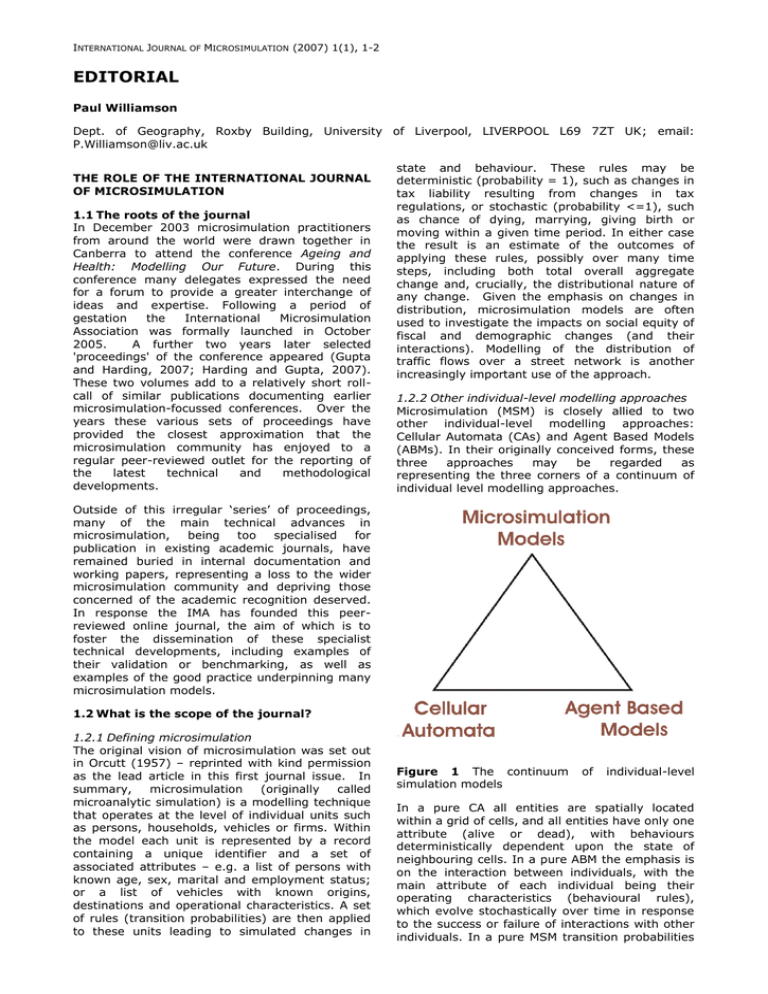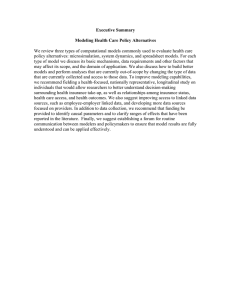The role of the International Journal of Microsimulation Paul
advertisement

INTERNATIONAL JOURNAL OF MICROSIMULATION (2007) 1(1), 1-2 EDITORIAL Paul Williamson Dept. of Geography, Roxby Building, University of Liverpool, LIVERPOOL L69 7ZT UK; email: P.Williamson@liv.ac.uk THE ROLE OF THE INTERNATIONAL JOURNAL OF MICROSIMULATION 1.1 The roots of the journal In December 2003 microsimulation practitioners from around the world were drawn together in Canberra to attend the conference Ageing and Health: Modelling Our Future. During this conference many delegates expressed the need for a forum to provide a greater interchange of ideas and expertise. Following a period of gestation the International Microsimulation Association was formally launched in October 2005. A further two years later selected 'proceedings' of the conference appeared (Gupta and Harding, 2007; Harding and Gupta, 2007). These two volumes add to a relatively short rollcall of similar publications documenting earlier microsimulation-focussed conferences. Over the years these various sets of proceedings have provided the closest approximation that the microsimulation community has enjoyed to a regular peer-reviewed outlet for the reporting of the latest technical and methodological developments. state and behaviour. These rules may be deterministic (probability = 1), such as changes in tax liability resulting from changes in tax regulations, or stochastic (probability <=1), such as chance of dying, marrying, giving birth or moving within a given time period. In either case the result is an estimate of the outcomes of applying these rules, possibly over many time steps, including both total overall aggregate change and, crucially, the distributional nature of any change. Given the emphasis on changes in distribution, microsimulation models are often used to investigate the impacts on social equity of fiscal and demographic changes (and their interactions). Modelling of the distribution of traffic flows over a street network is another increasingly important use of the approach. 1.2.2 Other individual-level modelling approaches Microsimulation (MSM) is closely allied to two other individual-level modelling approaches: Cellular Automata (CAs) and Agent Based Models (ABMs). In their originally conceived forms, these three approaches may be regarded as representing the three corners of a continuum of individual level modelling approaches. Outside of this irregular ‘series’ of proceedings, many of the main technical advances in microsimulation, being too specialised for publication in existing academic journals, have remained buried in internal documentation and working papers, representing a loss to the wider microsimulation community and depriving those concerned of the academic recognition deserved. In response the IMA has founded this peerreviewed online journal, the aim of which is to foster the dissemination of these specialist technical developments, including examples of their validation or benchmarking, as well as examples of the good practice underpinning many microsimulation models. 1.2 What is the scope of the journal? 1.2.1 Defining microsimulation The original vision of microsimulation was set out in Orcutt (1957) – reprinted with kind permission as the lead article in this first journal issue. In summary, microsimulation (originally called microanalytic simulation) is a modelling technique that operates at the level of individual units such as persons, households, vehicles or firms. Within the model each unit is represented by a record containing a unique identifier and a set of associated attributes – e.g. a list of persons with known age, sex, marital and employment status; or a list of vehicles with known origins, destinations and operational characteristics. A set of rules (transition probabilities) are then applied to these units leading to simulated changes in Figure 1 The continuum simulation models of individual-level In a pure CA all entities are spatially located within a grid of cells, and all entities have only one attribute (alive or dead), with behaviours deterministically dependent upon the state of neighbouring cells. In a pure ABM the emphasis is on the interaction between individuals, with the main attribute of each individual being their operating characteristics (behavioural rules), which evolve stochastically over time in response to the success or failure of interactions with other individuals. In a pure MSM transition probabilities WILLIAMSON Editorial lack evolutionary and spatial dimensions. As microsimulation models add more behavioural and spatial interaction between individual units, as CAs add a growing range of individual attributes and start to incorporate aspatial behaviours, and as ABMs add both space and fiscal/demographic characteristics to their agents, the three approaches move towards a common ground. 1.3 The format of the journal 1.3.1 Content As well as reprinting the seminal article by Orcutt, this first issue of the IJM contains three original fully peer-reviewed papers. Collectively they illustrate the range of papers that the journal invites. One reports how a non-representative sub-set of the population may be used to examine the practical implications of pension policy reforms; one explores new techniques for creating massively parallel computer simulations of disease spread; and one reviews the lessons to be drawn from existing health-related microsimulation models. This issue also features a first research note – a brief overview of the state of tax-benefit microsimulation amongst Eastern European countries. The Research Note section of the journal is reserved for shorter factual or opinion pieces. Also welcomed are short reports providing examples of microsimulation in use, or reviews of new software and hardware relevant to microsimulation. The issue concludes with a book review. For future issues, if you know of a recent software development or book which you would like reviewed, or if you would like to act as a reviewer yourself, please contact the editor. 1.3.2 Citation and Referencing Articles in the IJM may be cited in the usual manner, although the full reference for any article should include the URL. See, for example, the full reference to Dekkers (2007) given at the end of this editorial. 1.3.3 Article submission and pre-publication Intending authors are invited to submit articles for publication to the editor, preferably via email. Full details on acceptable electronic formats and the required style and layout of the paper are provided in the journal’s online style guide and notes for authors. The IJM is committed to speeding up the publication process. To this end, once the proofs of an article have been signed off by the contributing author(s) the article will be immediately placed online as part of the forthcoming issue preview. 1.3.4 Future directions As has hopefully been made clear, this is a journal designed to help a specific user community meet an unmet need. As such the journal belongs not to its sponsor, the International Microsimulation Association, nor to the Editorial Board, but to you 2 the reader. All comments and suggestions regarding the future direction(s) this journal should take are warmly welcomed. REFERENCES Dekkers G (2007) ‘The Financial Implications of Working Longer: An Application of a MicroEconomic Model of Retirement in Belgium’, International Journal of Microsimulation, 1(1), 10-25. (http://www.microsimulation.org/IJM/ V1_1/IJM_1_1_3.pdf) [accessed 1 October 2007] Gupta A and Harding A (Eds) (2007) Modelling Our Future: Population Ageing, Health and Aged Care, 16, Amsterdam: Elsevier B.V. Harding A and Gupta A (eds) (2007) Modelling Our Future: Population Ageing, Social Security and Taxation, 15, Amsterdam: Elsevier B.V. Orcutt G (1957) ‘A new type of socio-economic system’, Review of Economics and Statistics, 39(2), 116-123. (http://www.microsimulation .org/IJM/V1_1/IJM_1_1_2.pdf) [accessed 1 October 2007] ACKNOWLEDGEMENTS Thanks are due to the Editorial Board of the journal for their guidance and contribution to the life of this journal. Thanks also to the reviewers, past and future, who through their voluntary labours make the publication of this peer-reviewed journal possible.
